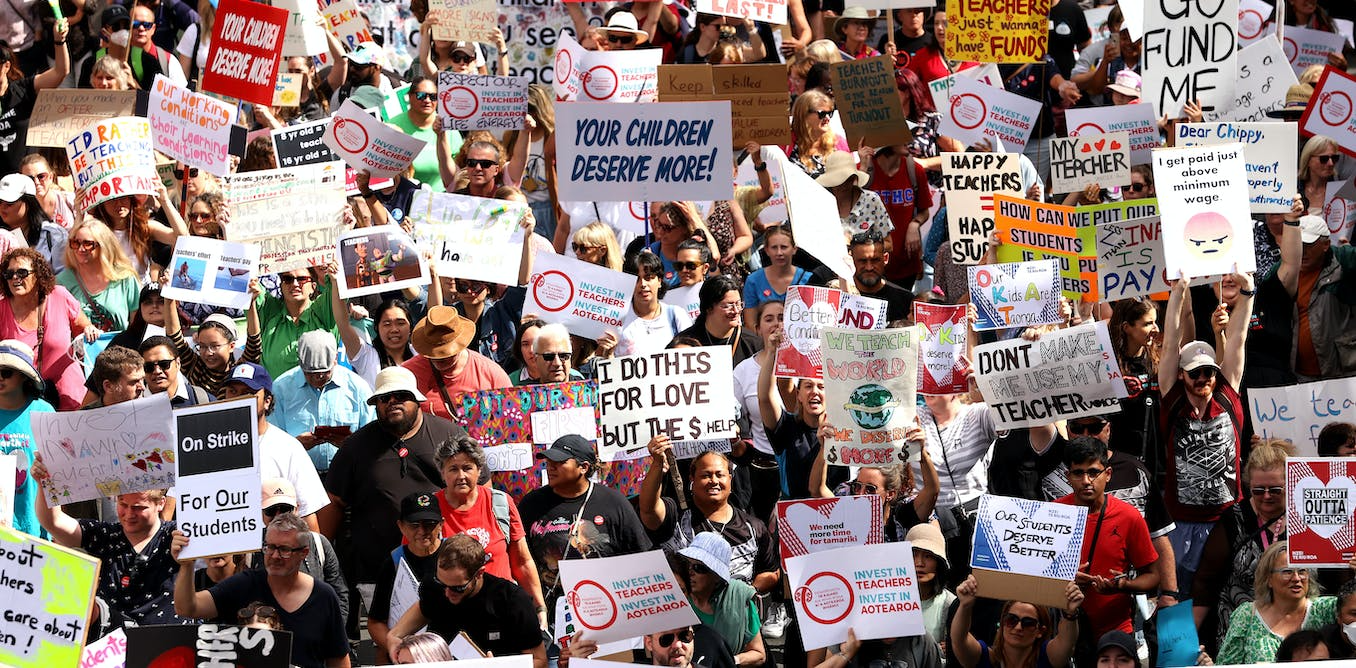Getty Images
Less than a fortnight after teachers staged a national strike, education was back in the headlines with the National Party’s release of its curriculum policy – or “rewrite”, as leader Christopher Luxon described it.
In a nutshell, the policy would require primary and intermediate schools to teach at least an hour a day each of reading, writing and maths. Learners in Years 3-8 would also be tested on their progress at least twice a year – not unlike the controversial (and subsequently dropped) national standards system from 2010 to 2018.
Prime Minister Chris Hipkins responded by arguing the school curriculum should ideally be a bipartisan issue rather than a political football: “Parents, kids, teachers deserve to know that we’ve got a stable curriculum regardless of who the government is.”
Clearly, we all want the best learning outcomes for our nation’s children. But there are deep ideological divisions in the debate about how best to teach and test school children. It seems the curriculum will inevitably become a partisan issue as the election year unfolds.
Behind this immediate contest of ideas, however, sits a larger question: does the education system need yet another upheaval when the curriculum is already undergoing a “refresh”?
How the curriculum works
The school curriculum is not set in stone. Since the 1989 Education Act, schools have been self-governing and charged with developing their own curriculum. These local curriculums are underpinned by the national New Zealand Curriculum and Te Marautanga o Aotearoa.
The national curriculum and school curriculums work in tandem to balance national consistency with localised enrichment. As part of the curriculum refresh now under way, Te Mātaiaho/The Curriculum Framework will replace the New Zealand Curriculum.
The latest version of Te Mātaiaho, which includes responses to school feedback last year, was released on March 17. It’s open for further input until May 12. Part of the process involves updating the eight learning areas – what many will recognise as the traditional school “subjects” – within a new “understand, know, do” model.
This model establishes key learning stage “progressions”. While it doesn’t go as far as National’s proposed year-by-year testing system, it does set out five consecutive phases: for years 1-3, 4-6, 7-8, 9-10 and 11-13. This replaces the current system of eight overlapping levels across years 0-13.
The new progressions are scheduled to be released for consultation in phases, with full implementation planned for 2026. The first “refreshed” learning area – te ao tangata/social sciences – was released last year. It includes the new Aotearoa New Zealand’s Histories curriculum, which schools are now required to teach.
The curriculum refresh also includes improvements to literacy and communication, and numeracy, including explicitly describing outcomes as a component of all learning areas. As part of the literacy and maths strategy, a common practice model is already being developed to create greater clarity, coherence and consistency across the school years.
Big workloads, inadequate funding: striking teachers arrive outside parliament on March 16. Getty Images
Teachers on the front line
The upshot of all this is that extensive curriculum work is well under way – and teachers and school leaders are already grappling with the implications. But the National Party curriculum policy implies these changes won’t go far enough.
If enacted, the proposed curriculum rewrite will require teachers to get their heads and hearts around even more change. This will include overseeing a new standardised testing regime in reading, writing and maths for years 3-8 – rather than solidifying their understanding of the current refresh.
More curriculum change is assuredly not what teachers were calling for when they went on strike on March 16. Rather, they were drawing attention to working conditions and pay scales that haven’t kept pace with inflation.
Mainstream reporting and social media posts overflowed with teachers and principals sharing experiences of increasing concerns about the wellbeing of students and staff. They spoke of overwhelming workloads and inadequate funding to support students with complex learning and behavioural needs.
Christopher Luxon addressed this broader educational complexity head-on, speaking directly to teachers: “In addition to teaching, you have become the front-line response to complex social, educational, housing and wellbeing challenges.”
Beyond the school gates
Of course, a strong curriculum and clear milestones for progress are important. But we also need to recognise that quality education occurs within a complex milieu of wider social and economic policies.
If Chris Hipkins’ desire for a bipartisan approach to education were to work, it would be good to see the educational policies of different political parties directly address the funding issue for schools.
Beyond that, how does school funding intersect with other policies targeting inequality and inequity outside the school gates? The same day National announced its curriculum policy, child poverty again made the headlines. A new report showed 10% of the nation’s children are living in material hardship.
Having school children arrive at school properly fed, warm, well dressed and ready to learn is surely the priority. Teachers will then be able to focus on implementing the curriculum for everyone’s benefit.![]()
- Cathy Buntting, Director, Wilf Malcolm Institute of Educational Research, University of Waikato


